INFINITI G-CONVERTIBLE 2011 Service Manual
Manufacturer: INFINITI, Model Year: 2011, Model line: G-CONVERTIBLE, Model: INFINITI G-CONVERTIBLE 2011Pages: 458, PDF Size: 3.83 MB
Page 41 of 458
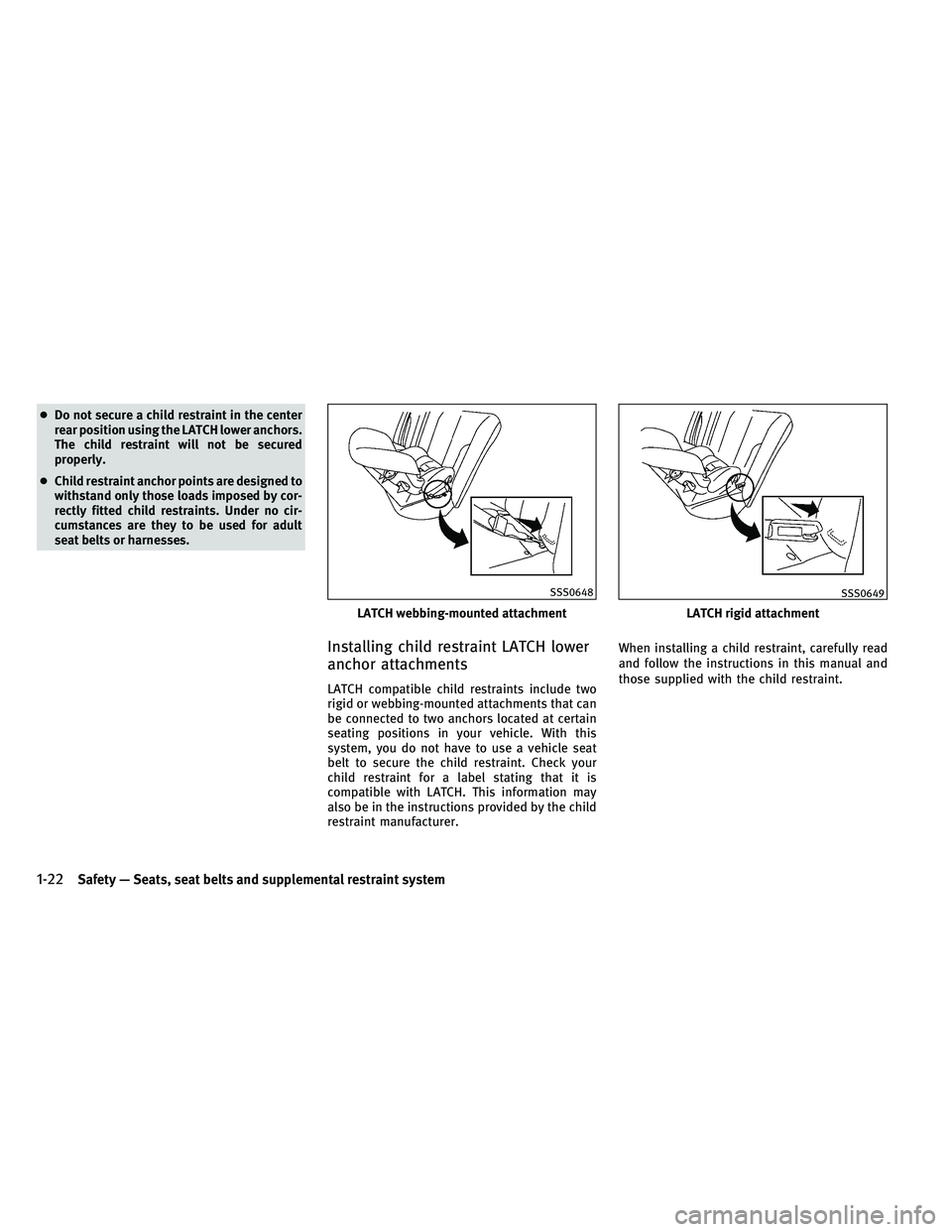
●Do not secure a child restraint in the center
rear position using the LATCH lower anchors.
The child restraint will not be secured
properly.
● Child restraint anchor points are designed to
withstand only those loads imposed by cor-
rectly fitted child restraints. Under no cir-
cumstances are they to be used for adult
seat belts or harnesses.
Installing child restraint LATCH lower
anchor attachments
LATCH compatible child restraints include two
rigid or webbing-mounted attachments that can
be connected to two anchors located at certain
seating positions in your vehicle. With this
system, you do not have to use a vehicle seat
belt to secure the child restraint. Check your
child restraint for a label stating that it is
compatible with LATCH. This information may
also be in the instructions provided by the child
restraint manufacturer. When installing a child restraint, carefully read
and follow the instructions in this manual and
those supplied with the child restraint.
LATCH webbing-mounted attachment
SSS0648
LATCH rigid attachment
SSS0649
1-22Safety — Seats, seat belts and supplemental restraint system
Page 42 of 458
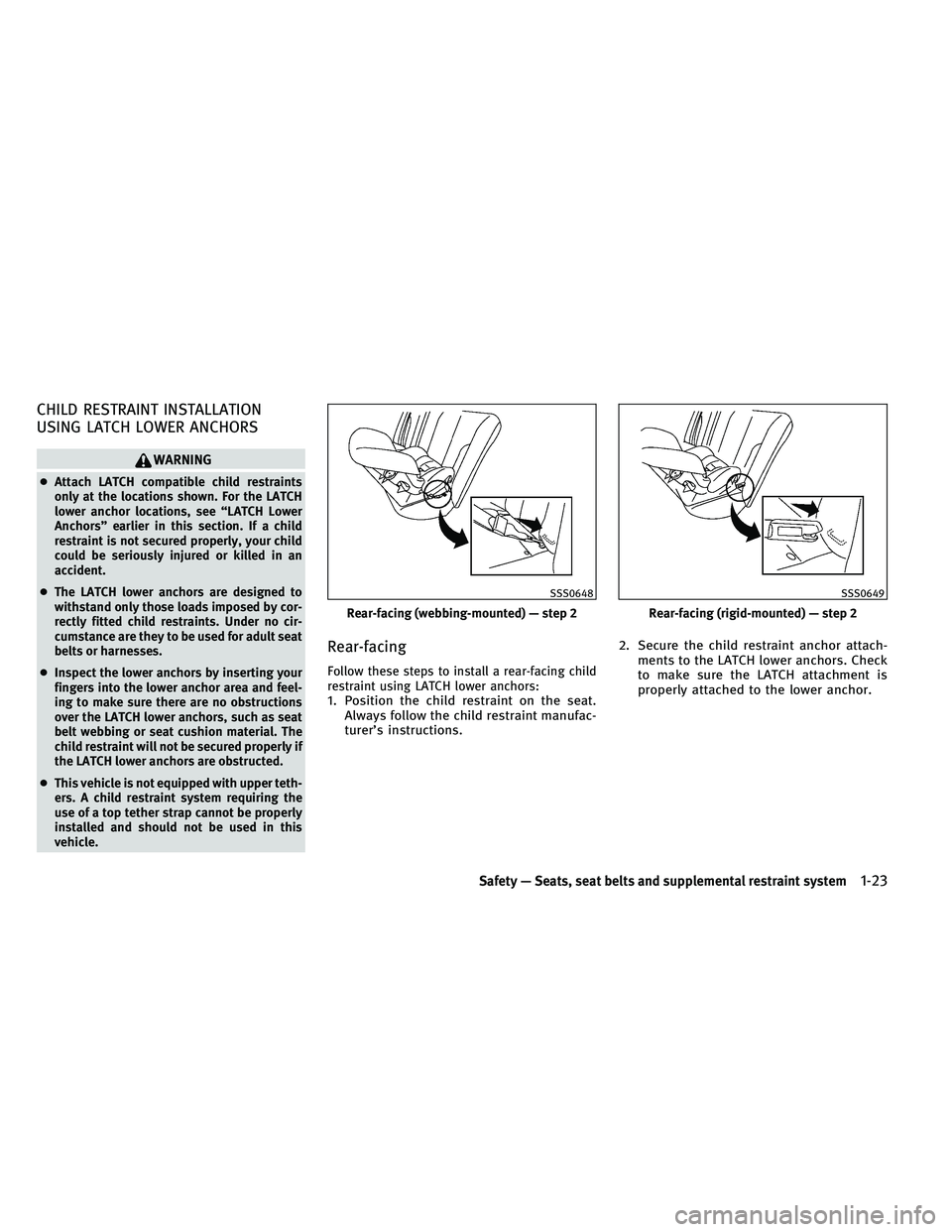
CHILD RESTRAINT INSTALLATION
USING LATCH LOWER ANCHORS
WARNING
●Attach LATCH compatible child restraints
only at the locations shown. For the LATCH
lower anchor locations, see “LATCH Lower
Anchors” earlier in this section. If a child
restraint is not secured properly, your child
could be seriously injured or killed in an
accident.
● The LATCH lower anchors are designed to
withstand only those loads imposed by cor-
rectly fitted child restraints. Under no cir-
cumstance are they to be used for adult seat
belts or harnesses.
● Inspect the lower anchors by inserting your
fingers into the lower anchor area and feel-
ing to make sure there are no obstructions
over the LATCH lower anchors, such as seat
belt webbing or seat cushion material. The
child restraint will not be secured properly if
the LATCH lower anchors are obstructed.
● This vehicle is not equipped with upper teth-
ers. A child restraint system requiring the
use of a top tether strap cannot be properly
installed and should not be used in this
vehicle.
Rear-facing
Follow these steps to install a rear-facing child
restraint using LATCH lower anchors:
1. Position the child restraint on the seat. Always follow the child restraint manufac-
turer’s instructions. 2. Secure the child restraint anchor attach-
ments to the LATCH lower anchors. Check
to make sure the LATCH attachment is
properly attached to the lower anchor.
Rear-facing (webbing-mounted) — step 2
SSS0648
Rear-facing (rigid-mounted) — step 2
SSS0649
Safety — Seats, seat belts and supplemental restraint system1-23
Page 43 of 458
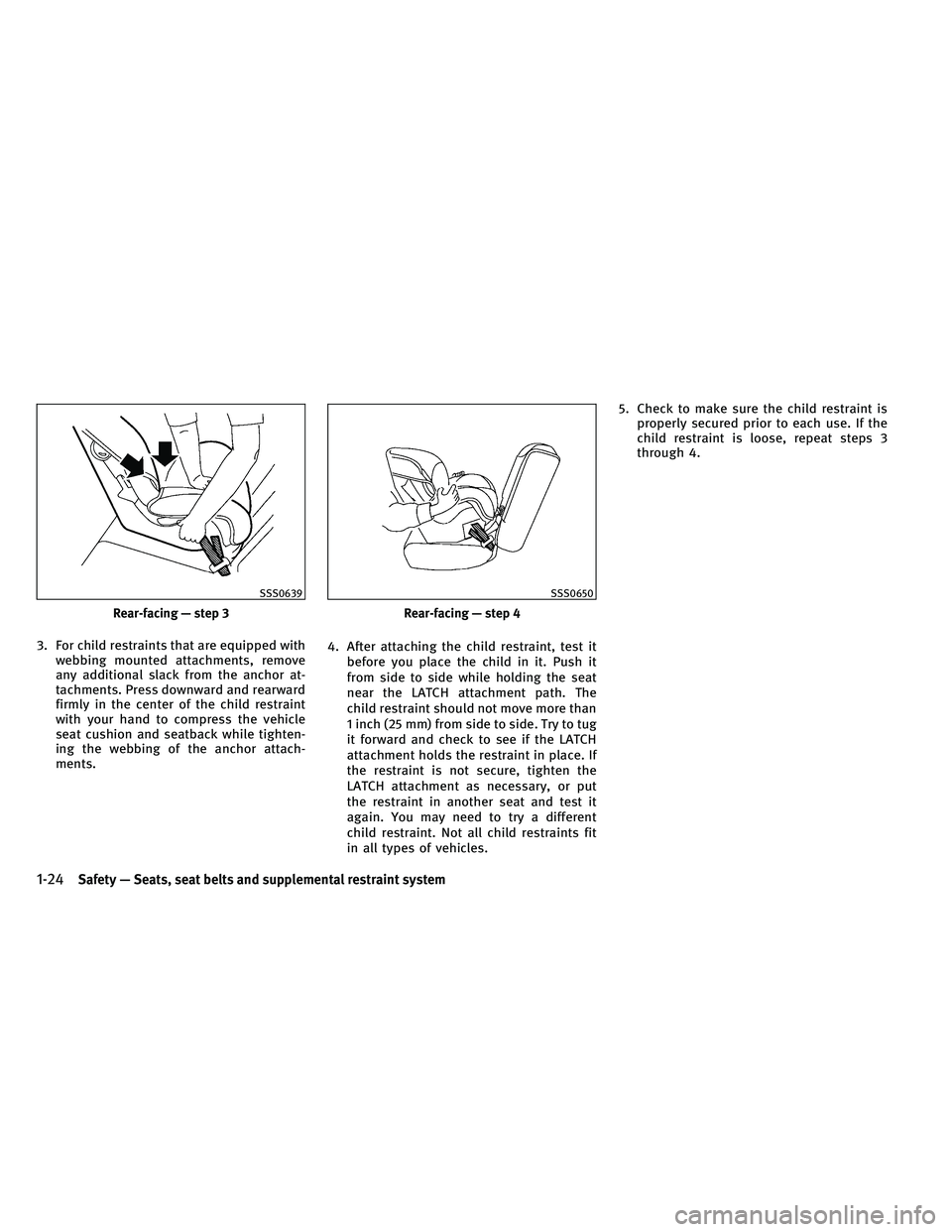
3. For child restraints that are equipped withwebbing mounted attachments, remove
any additional slack from the anchor at-
tachments. Press downward and rearward
firmly in the center of the child restraint
with your hand to compress the vehicle
seat cushion and seatback while tighten-
ing the webbing of the anchor attach-
ments. 4. After attaching the child restraint, test it
before you place the child in it. Push it
from side to side while holding the seat
near the LATCH attachment path. The
child restraint should not move more than
1 inch (25 mm) from side to side. Try to tug
it forward and check to see if the LATCH
attachment holds the restraint in place. If
the restraint is not secure, tighten the
LATCH attachment as necessary, or put
the restraint in another seat and test it
again. You may need to try a different
child restraint. Not all child restraints fit
in all types of vehicles. 5. Check to make sure the child restraint is
properly secured prior to each use. If the
child restraint is loose, repeat steps 3
through 4.
Rear-facing — step 3
SSS0639
Rear-facing — step 4
SSS0650
1-24Safety — Seats, seat belts and supplemental restraint system
Page 44 of 458
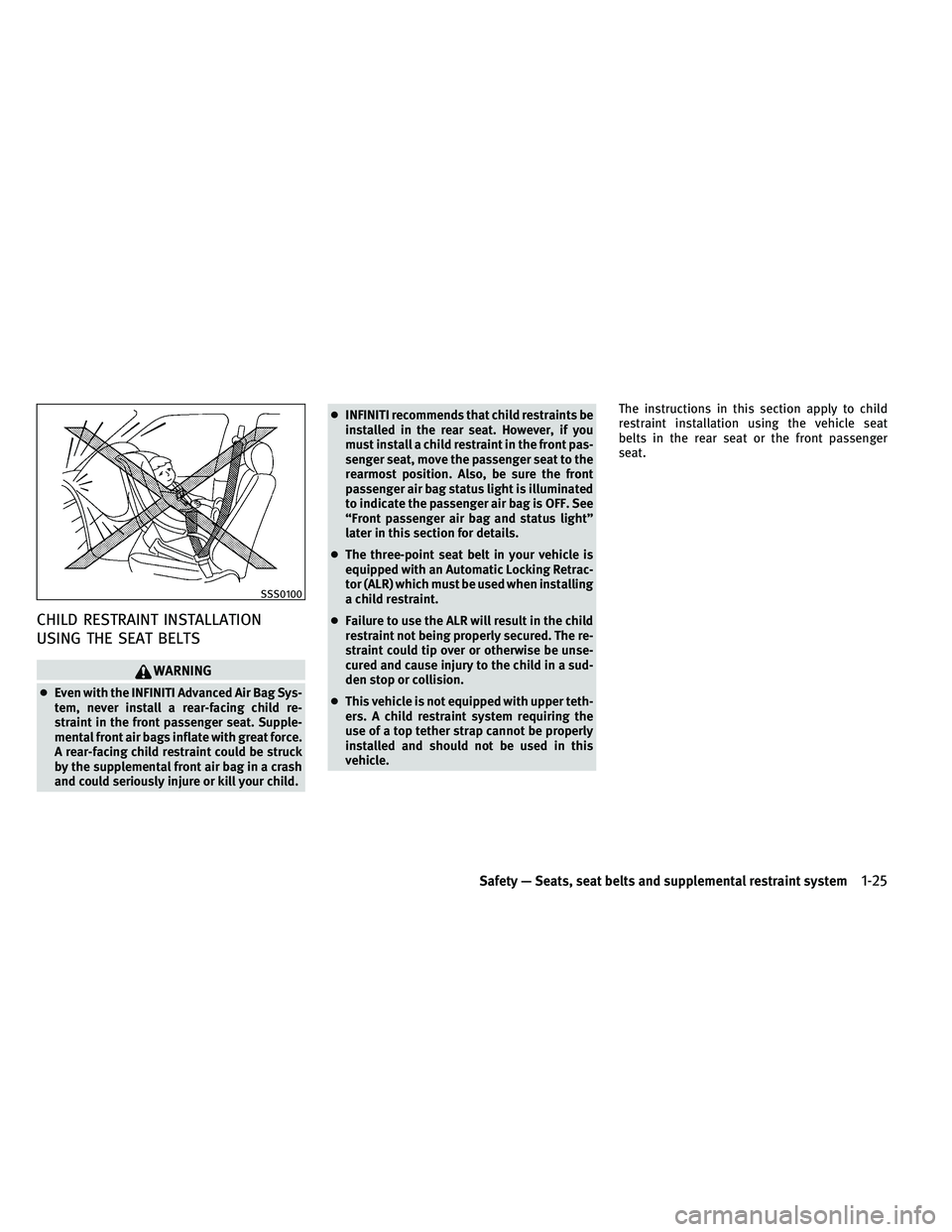
CHILD RESTRAINT INSTALLATION
USING THE SEAT BELTS
WARNING
●Even with the INFINITI Advanced Air Bag Sys-
tem, never install a rear-facing child re-
straint in the front passenger seat. Supple-
mental front air bags inflate with great force.
A rear-facing child restraint could be struck
by the supplemental front air bag in a crash
and could seriously injure or kill your child. ●
INFINITI recommends that child restraints be
installed in the rear seat. However, if you
must install a child restraint in the front pas-
senger seat, move the passenger seat to the
rearmost position. Also, be sure the front
passenger air bag status light is illuminated
to indicate the passenger air bag is OFF. See
“Front passenger air bag and status light”
later in this section for details.
● The three-point seat belt in your vehicle is
equipped with an Automatic Locking Retrac-
tor (ALR) which must be used when installing
a child restraint.
● Failure to use the ALR will result in the child
restraint not being properly secured. The re-
straint could tip over or otherwise be unse-
cured and cause injury to the child in a sud-
den stop or collision.
● This vehicle is not equipped with upper teth-
ers. A child restraint system requiring the
use of a top tether strap cannot be properly
installed and should not be used in this
vehicle. The instructions in this section apply to child
restraint installation using the vehicle seat
belts in the rear seat or the front passenger
seat.
SSS0100
Safety — Seats, seat belts and supplemental restraint system1-25
Page 45 of 458
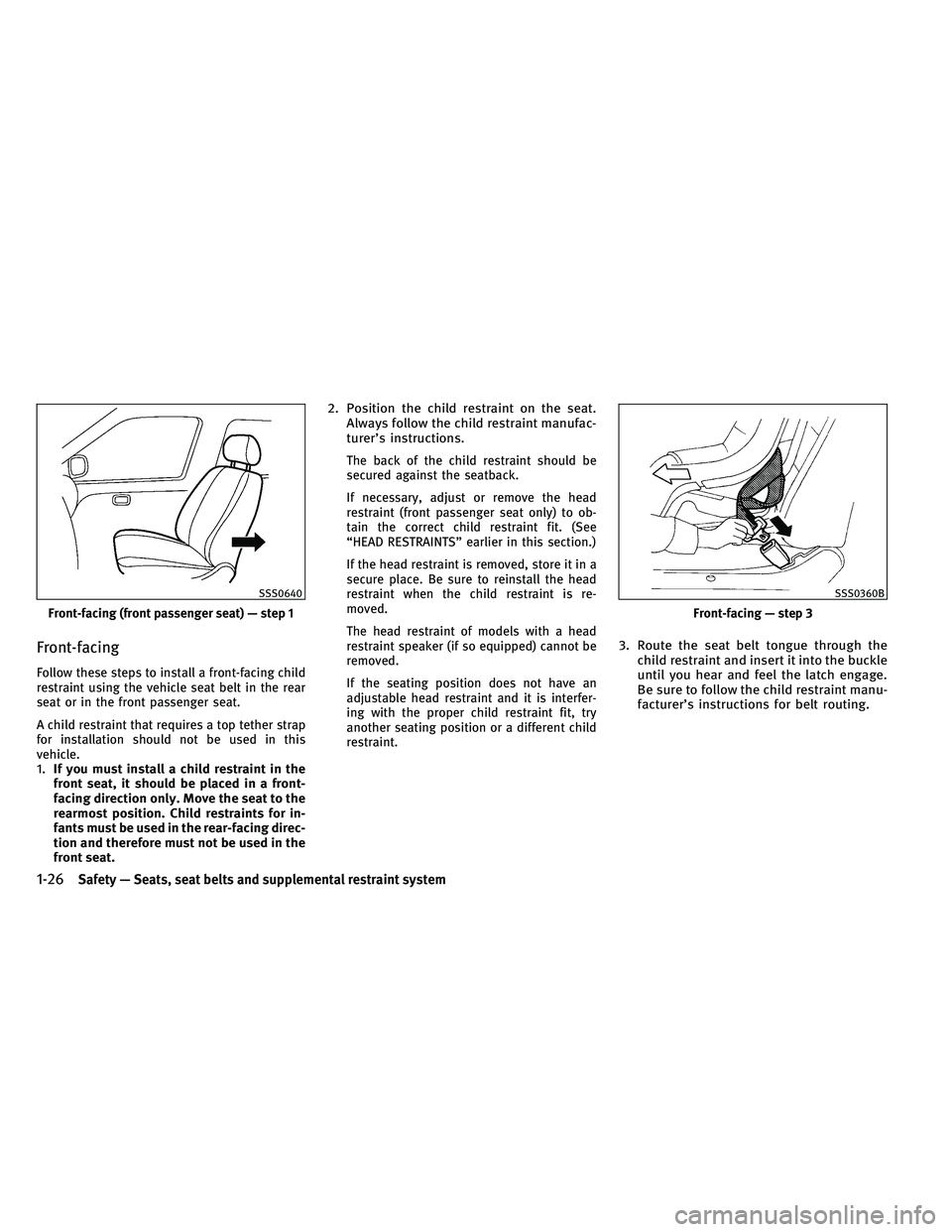
Front-facing
Follow these steps to install a front-facing child
restraint using the vehicle seat belt in the rear
seat or in the front passenger seat.
A child restraint that requires a top tether strap
for installation should not be used in this
vehicle.
1.If you must install a child restraint in the
front seat, it should be placed in a front-
facing direction only. Move the seat to the
rearmost position. Child restraints for in-
fants must be used in the rear-facing direc-
tion and therefore must not be used in the
front seat. 2. Position the child restraint on the seat.
Always follow the child restraint manufac-
turer’s instructions.
The back of the child restraint should be
secured against the seatback.
If necessary, adjust or remove the head
restraint (front passenger seat only) to ob-
tain the correct child restraint fit. (See
“HEAD RESTRAINTS” earlier in this section.)
If the head restraint is removed, store it in a
secure place. Be sure to reinstall the head
restraint when the child restraint is re-
moved.
The head restraint of models with a head
restraint speaker (if so equipped) cannot be
removed.
If the seating position does not have an
adjustable head restraint and it is interfer-
ing with the proper child restraint fit, try
another seating position or a different child
restraint.
3. Route the seat belt tongue through thechild restraint and insert it into the buckle
until you hear and feel the latch engage.
Be sure to follow the child restraint manu-
facturer’s instructions for belt routing.
Front-facing (front passenger seat) — step 1
SSS0640
Front-facing — step 3
SSS0360B
1-26Safety — Seats, seat belts and supplemental restraint system
Page 46 of 458
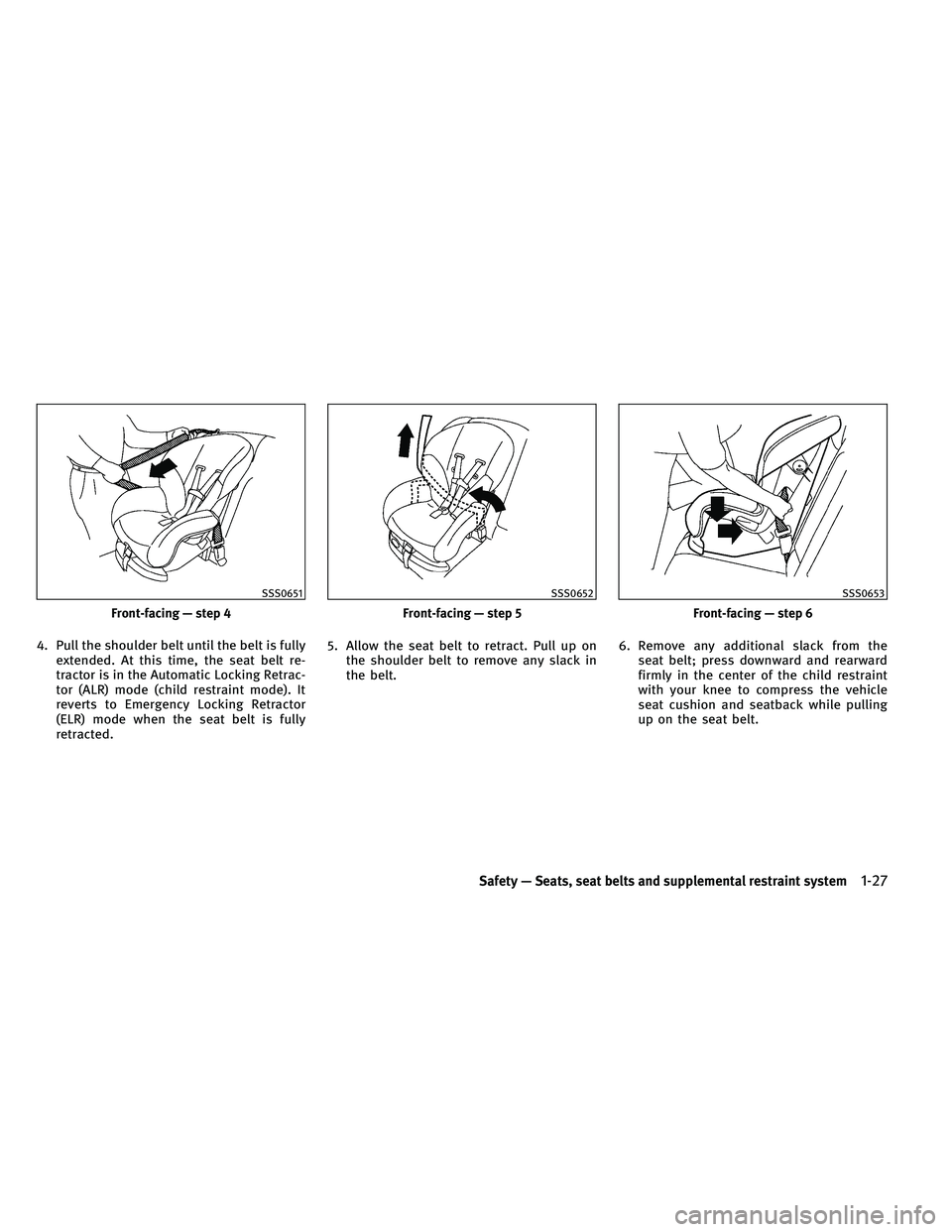
4. Pull the shoulder belt until the belt is fullyextended. At this time, the seat belt re-
tractor is in the Automatic Locking Retrac-
tor (ALR) mode (child restraint mode). It
reverts to Emergency Locking Retractor
(ELR) mode when the seat belt is fully
retracted. 5. Allow the seat belt to retract. Pull up on
the shoulder belt to remove any slack in
the belt. 6. Remove any additional slack from the
seat belt; press downward and rearward
firmly in the center of the child restraint
with your knee to compress the vehicle
seat cushion and seatback while pulling
up on the seat belt.
Front-facing — step 4
SSS0651
Front-facing — step 5
SSS0652
Front-facing — step 6
SSS0653
Safety — Seats, seat belts and supplemental restraint system1-27
Page 47 of 458
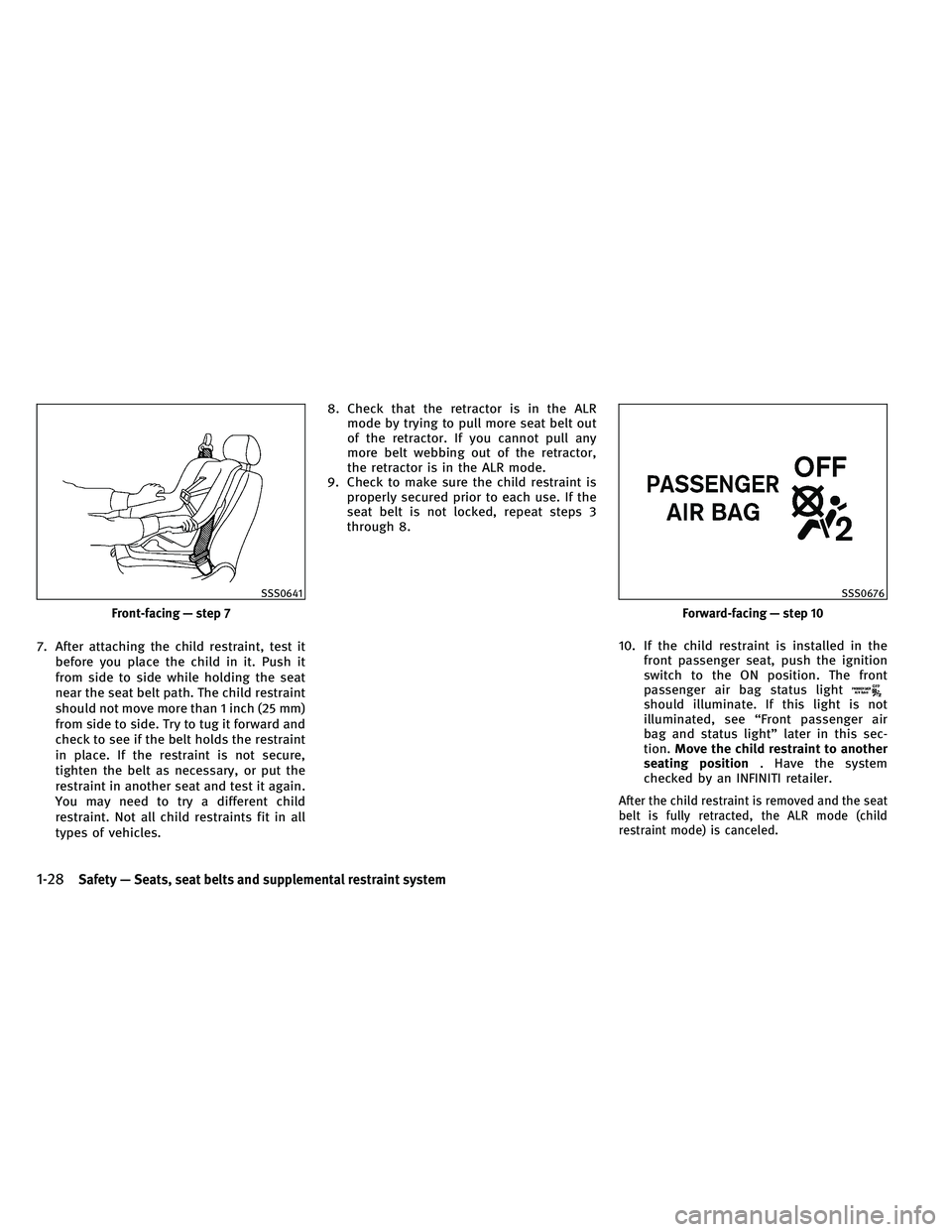
7. After attaching the child restraint, test itbefore you place the child in it. Push it
from side to side while holding the seat
near the seat belt path. The child restraint
should not move more than 1 inch (25 mm)
from side to side. Try to tug it forward and
check to see if the belt holds the restraint
in place. If the restraint is not secure,
tighten the belt as necessary, or put the
restraint in another seat and test it again.
You may need to try a different child
restraint. Not all child restraints fit in all
types of vehicles. 8. Check that the retractor is in the ALR
mode by trying to pull more seat belt out
of the retractor. If you cannot pull any
more belt webbing out of the retractor,
the retractor is in the ALR mode.
9. Check to make sure the child restraint is properly secured prior to each use. If the
seat belt is not locked, repeat steps 3
through 8.
10. If the child restraint is installed in thefront passenger seat, push the ignition
switch to the ON position. The front
passenger air bag status light
should illuminate. If this light is not
illuminated, see “Front passenger air
bag and status light” later in this sec-
tion. Move the child restraint to another
seating position . Have the system
checked by an INFINITI retailer.
After the child restraint is removed and the seat
belt is fully retracted, the ALR mode (child
restraint mode) is canceled.
Front-facing — step 7
SSS0641
Forward-facing — step 10
SSS0676
1-28Safety — Seats, seat belts and supplemental restraint system
Page 48 of 458
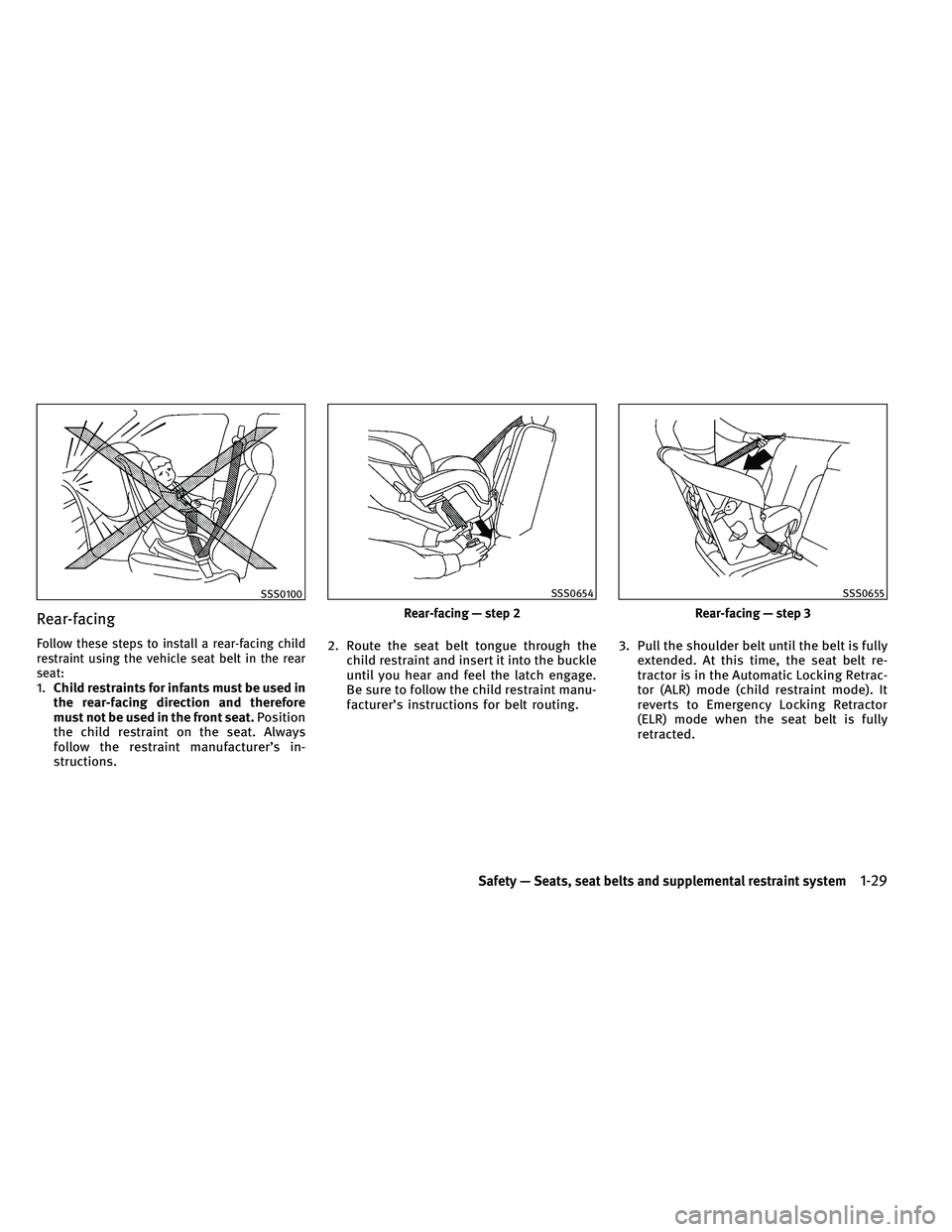
Rear-facing
Follow these steps to install a rear-facing child
restraint using the vehicle seat belt in the rear
seat:
1.Child restraints for infants must be used in
the rear-facing direction and therefore
must not be used in the front seat. Position
the child restraint on the seat. Always
follow the restraint manufacturer’s in-
structions. 2. Route the seat belt tongue through the
child restraint and insert it into the buckle
until you hear and feel the latch engage.
Be sure to follow the child restraint manu-
facturer’s instructions for belt routing. 3. Pull the shoulder belt until the belt is fully
extended. At this time, the seat belt re-
tractor is in the Automatic Locking Retrac-
tor (ALR) mode (child restraint mode). It
reverts to Emergency Locking Retractor
(ELR) mode when the seat belt is fully
retracted.
SSS0100
Rear-facing — step 2
SSS0654
Rear-facing — step 3
SSS0655
Safety — Seats, seat belts and supplemental restraint system1-29
Page 49 of 458
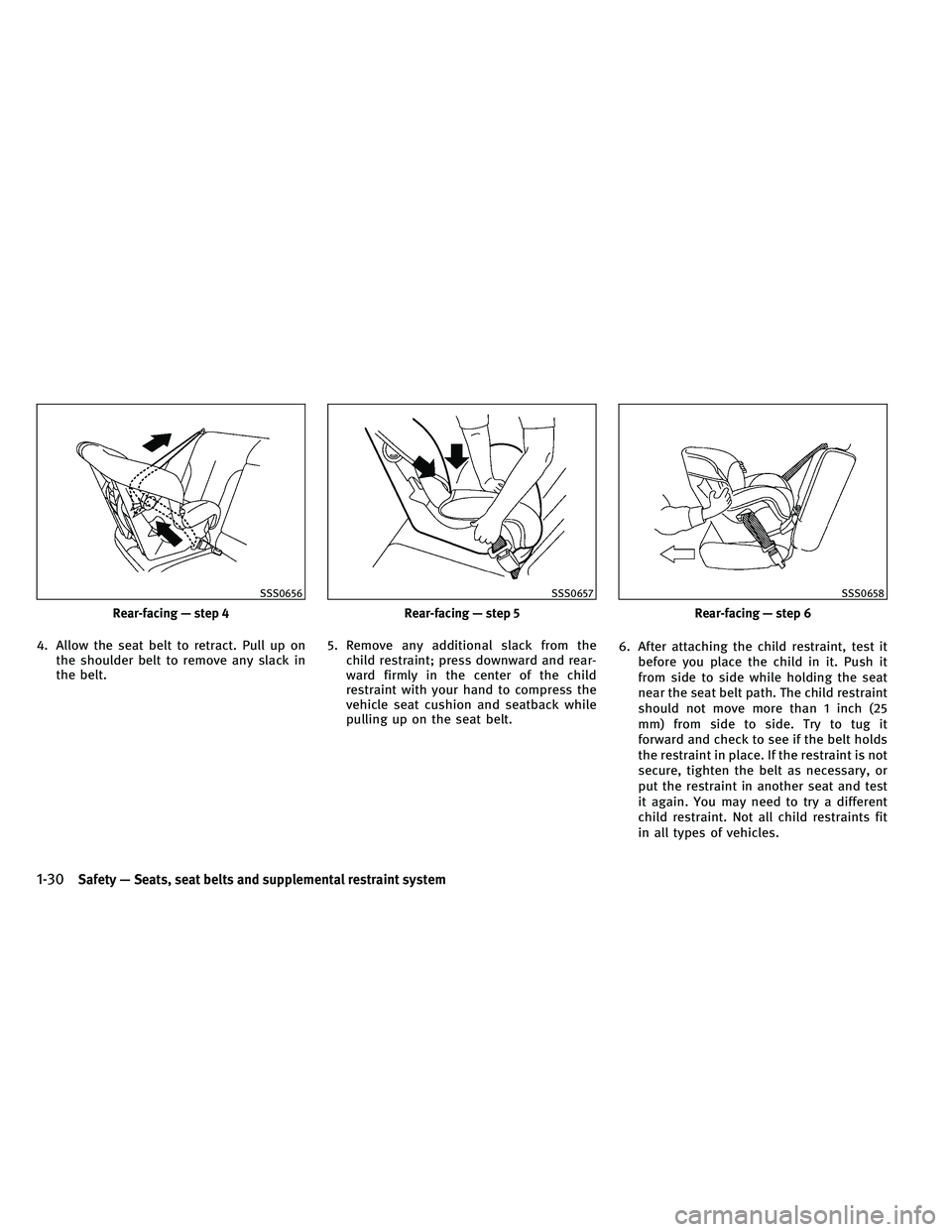
4. Allow the seat belt to retract. Pull up onthe shoulder belt to remove any slack in
the belt. 5. Remove any additional slack from the
child restraint; press downward and rear-
ward firmly in the center of the child
restraint with your hand to compress the
vehicle seat cushion and seatback while
pulling up on the seat belt. 6. After attaching the child restraint, test it
before you place the child in it. Push it
from side to side while holding the seat
near the seat belt path. The child restraint
should not move more than 1 inch (25
mm) from side to side. Try to tug it
forward and check to see if the belt holds
the restraint in place. If the restraint is not
secure, tighten the belt as necessary, or
put the restraint in another seat and test
it again. You may need to try a different
child restraint. Not all child restraints fit
in all types of vehicles.
Rear-facing — step 4
SSS0656
Rear-facing — step 5
SSS0657
Rear-facing — step 6
SSS0658
1-30Safety — Seats, seat belts and supplemental restraint system
Page 50 of 458
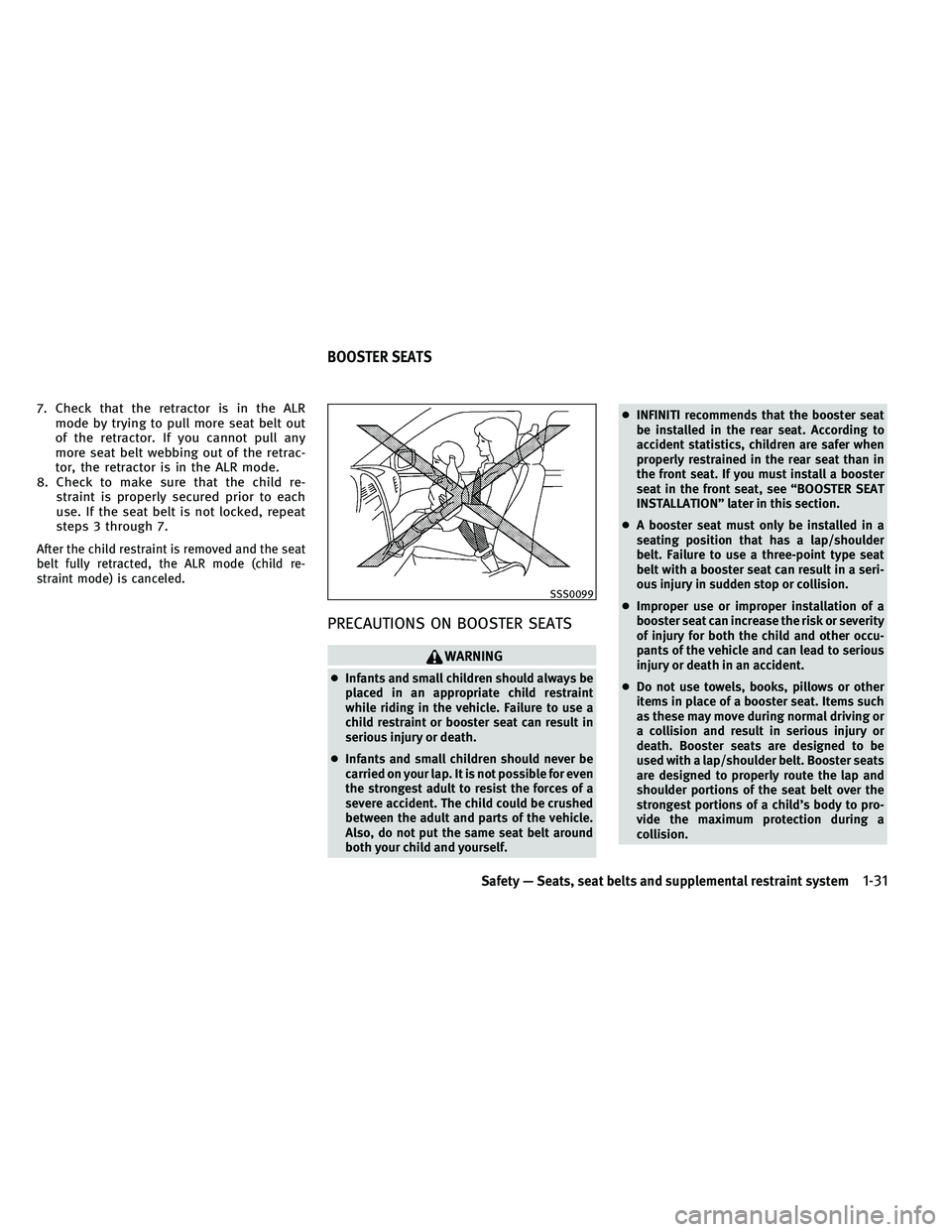
7. Check that the retractor is in the ALRmode by trying to pull more seat belt out
of the retractor. If you cannot pull any
more seat belt webbing out of the retrac-
tor, the retractor is in the ALR mode.
8. Check to make sure that the child re- straint is properly secured prior to each
use. If the seat belt is not locked, repeat
steps 3 through 7.
After the child restraint is removed and the seat
belt fully retracted, the ALR mode (child re-
straint mode) is canceled.
PRECAUTIONS ON BOOSTER SEATS
WARNING
●Infants and small children should always be
placed in an appropriate child restraint
while riding in the vehicle. Failure to use a
child restraint or booster seat can result in
serious injury or death.
● Infants and small children should never be
carried on your lap. It is not possible for even
the strongest adult to resist the forces of a
severe accident. The child could be crushed
between the adult and parts of the vehicle.
Also, do not put the same seat belt around
both your child and yourself. ●
INFINITI recommends that the booster seat
be installed in the rear seat. According to
accident statistics, children are safer when
properly restrained in the rear seat than in
the front seat. If you must install a booster
seat in the front seat, see “BOOSTER SEAT
INSTALLATION” later in this section.
● A booster seat must only be installed in a
seating position that has a lap/shoulder
belt. Failure to use a three-point type seat
belt with a booster seat can result in a seri-
ous injury in sudden stop or collision.
● Improper use or improper installation of a
booster seat can increase the risk or severity
of injury for both the child and other occu-
pants of the vehicle and can lead to serious
injury or death in an accident.
● Do not use towels, books, pillows or other
items in place of a booster seat. Items such
as these may move during normal driving or
a collision and result in serious injury or
death. Booster seats are designed to be
used with a lap/shoulder belt. Booster seats
are designed to properly route the lap and
shoulder portions of the seat belt over the
strongest portions of a child’s body to pro-
vide the maximum protection during a
collision.
SSS0099
BOOSTER SEATS
Safety — Seats, seat belts and supplemental restraint system1-31